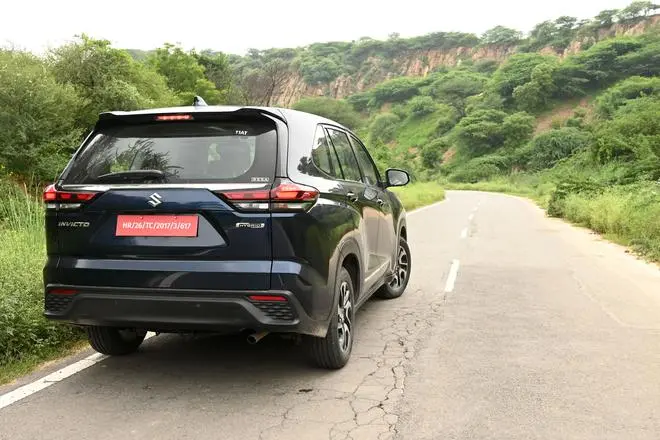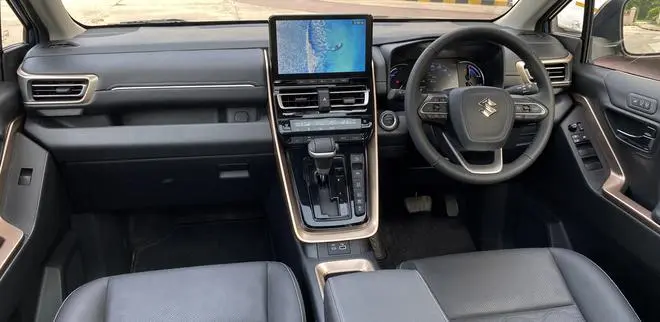The Toyota-Suzuki alliance in India has already spawned three shared models that have helped the two brands speed up their gestation to market in segments that they weren’t present in before. Toyota’s India portfolio was lacking in vehicles in the lower priced segments after the Etios’s demise. But the alliance helped Toyota enter the premium small car and the compact SUV categories with the Glanza and the Urban Cruiser Hyryder respectively. For Maruti Suzuki, the alliance enabled it to get access to Toyota’s strong hybrid technology in the Grand Vitara. And now, the marriage of convenience and synergies will enable Maruti Suzuki to enter a completely new market for a premium family van in the new Invicto. The premium MPV market has been dominated by Toyota’s Innova for decades. After the launch of the Innova Hycross with strong hybrid tech, Toyota created a sort of parallel new-gen version of the Innova that was more focused on individual buyers. The Hycross has further elevated the image of the Innova brand for Toyota with ADAS functions making a debut in the model.

At the rear, the fender has been marginally reworked and there is a chrome bar garnish that heightens the perception of width just below the rear glass | Photo Credit: BIJOY GHOSH
So, does the Maruti Suzuki Invicto also deliver on its promises to buyers? What remains the same and what is different between the two? Here’s my take after spending a little over a day driving it in and around the national capital.
Design
First, despite the rather obvious similarities between models, the Toyota-Suzuki alliance is a well thought out plan to leverage brand identities and strengths. It is also meant to take advantage of unified sourcing and production. So, though the launch of the Toyota Innova Hycross and the Maruti Suzuki Invicto have been separated by months, they were both conceived together, and their features specifically chosen to represent the respective brands. Royalties are paid between the two based on who developed the shared vehicles and the tech in them. In the run-up to the alliance developing completely different vehicles on the same platform, it seems like the immediate plan has been to speed up access to new market segments with as little extra investment as possible.
So, the Invicto is almost identical to the Innova Hycross in its exterior dimensions and design, except for specific elements (mostly plastic parts) that have been altered to reflect Maruti’s Nexa design lineage. From the side profile, the Invicto and Hycross are almost impossible to distinguish. The only giveaway are the alloy wheels, which in the Invicto are smaller 17-inch rims (compared to the 18-inch in the two top trims of the Hycross). These alloys are also constructed differently and, of course, sport the Suzuki ‘S’ logo. The body panels are identical, and the window and rooflines are the same too. At the front, the Invicto sports a slightly reprofiled fender and the grille sports the Maruti Nexa dual slats in chrome at the top with the trademark honeycomb and hexagonal bottoms frame. The headlamp housing is the same as in the Hycross, though the configuration is different and includes the trio of main LED lights that is also a Nexa trademark. At the rear too, the fender has been marginally reworked. There is a chrome bar garnish that heightens the perception of width just below the rear glass. And the tail-lamp configuration mimics the orientation in a couple of other Maruti Nexa vehicles, while the housing itself remains the same. But, after being more attuned to seeing sub-four-metre hatches and sedans from Maruti, it is a bit of a jolt to see a near 4.8-metre aggressive MPV sporting the same logo.
Cabin
Stepping into the cabin before I drive off to the outskirts of Gurugram, I observe that the designers have abstained from making too many changes to the interior too. The dashboard layout is very similar to the Hycross. But some elements look and feel at home in a Suzuki, especially being one from the Nexa channel. So, it is possible that things like the aircon vents and the orientation for some of the IP elements were designed to be neutral and acceptable for either of the two brands. The test mule I was driving was the top-spec Alpha+ 7-seater with the automatic e-CVT gearbox. The Invicto gets the same awesome driving position and driver-oriented cabin layout. Black and dark grey colour theme lends the cabin a very European, upmarket flavour. The Invicto gets matt champagne-gold trim accents instead of the brown and matt-silver theme that the Hycross has.

A powered tailgate, soft-touch stitched crash pad on the dash, memory seats and ambient lighting are pleasantly fresh features in a Maruti | Photo Credit: BIJOY GHOSH
Perforated leatherette seats for the driver and front passenger offers ventilation. The fully automatic climate control with a dedicated rear unit and vents for second and third row passengers makes the cabin cool very quickly. With the addition of a double-pane panoramic sunroof, the second-row vents are on the B-pillar just like in the Hycross. My test mule featured captain seats for the second row with reclinable backrests which slide forward to offer easy access to the third-row bench seat. The space available for passengers in terms of legroom and kneeroom is identical to the Hycross which means it is more than enough for adults seated in second row and just about adequate if they were to be seated in the third row. Headroom for last row occupants may be limited if they are of above average height. The chunky wrapped steering wheel is also great to hold with multiple controls on the centre spokes. The instrument cluster is a mix of analog dials and a digital MID in the middle.
Some of the features of the Invicto’s cabin are totally new in a Maruti Suzuki vehicle. A powered tailgate, soft-touch stitched crash pad on the dash, memory seats and ambient lighting are pleasantly fresh features in a Maruti. There are still some differentiators between the Innova Hycross and the Invicto; for example, the latter doesn’t the get the higher-end JBL music system, or the powered ottoman footrest for the middle row captain seats even for the top trim. The 10.1-inch touchscreen infotainment system also feels a level lower in quality. But the Invicto’s focus on safety will warm the hearts of buyers in this premium segment. Six airbags, ABS, hill-start assist and electronic stability control etc., are offered, though ADAS features (offered in the top-trim Innova Hycross) are missing in the Invicto. But it does get 50-plus connected features using the Suzuki Connect app.
Performance
The Maruti Suzuki Invicto only gets the petrol hybrid powertrain, unlike the Innova Hycross which gets this in addition to the petrol only unit. The engine is the TNGA (Toyota New Global Architecture) 2-litre, 4-cylinder petrol unit which is combined with a strong hybrid battery-electric system. The same fifth generation self-charging BE system from the Hycross involves a 1.6kWh nickel-metal hydride battery pack and an electric motor that powers the front wheels using an e-drive transmission. Based on the system’s state of charge, the Invicto starts off in EV mode and can do quite a distance in hybrid electric only mode. The range is dependent on speed, throttle input and state of charge. The 1,987cc petrol engine delivers about 152hp of peak power and torque of about 188Nm. The electric motor delivers series and parallel assist and the torque fed to the front wheels by the motor is 206Nm. The combined power output is about 184hp. The 2-litre Atkinson cycle engine is silky smooth, quiet, and refined, but hard throttle inputs don’t elicit immediate responses. Throttle mapping has been set for relatively relaxed driving, though there is a mid-range that one can work with, the engine starts feeling laboured even as the top third of the rev band comes up. There are three drive modes to choose from and the sports mode feels the peppiest.
On the go, there is no sense of the weight of the Invicto. The ride quality is very similar to the Innova Hycross with excellent damping and a marginally wallowy ride on clean but undulating tarmac. Maruti has focused on a more conventional setup for rough roads with its choice of 17-inch wheels.
Bottom Line
Multiple brands have failed to capitalise on badge-engineered vehicles. Two seemingly unrelated brands having vehicles that are almost identical can be very confusing for buyers. The key is to get into the mind of the buyer without any guile or tactic and present the strengths and weaknesses of each brand, and how the vehicles are still relevant. So, it is good to see that Maruti Suzuki isn’t attempting to reinvent itself with the Invicto. It is probably going to test the waters with the first vehicle bearing the Suzuki logo and which will cost the buyer upwards of ₹30 lakh on the road.
That will be a worthy enough pursuit. It has the potential to boost the image of Maruti and the Nexa channel, while also creating new brand loyalties. After all, what drove so many buyers to choose the Toyota Glanza over the Maruti Suzuki Baleno. With such long waiting lists, even availability could drive buyers to either of the brands. Prices for the three variants of the Maruti Suzuki Invicto range from ₹24.8 lakh for the Zeta+ 7-seater to ₹24.84 lakh for the Zeta+ 8-seater and ₹28.42 lakh for the Alpha+ 7-seater.





Comments
Comments have to be in English, and in full sentences. They cannot be abusive or personal. Please abide by our community guidelines for posting your comments.
We have migrated to a new commenting platform. If you are already a registered user of TheHindu Businessline and logged in, you may continue to engage with our articles. If you do not have an account please register and login to post comments. Users can access their older comments by logging into their accounts on Vuukle.